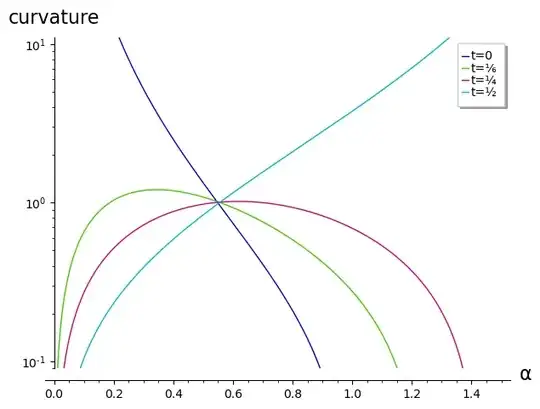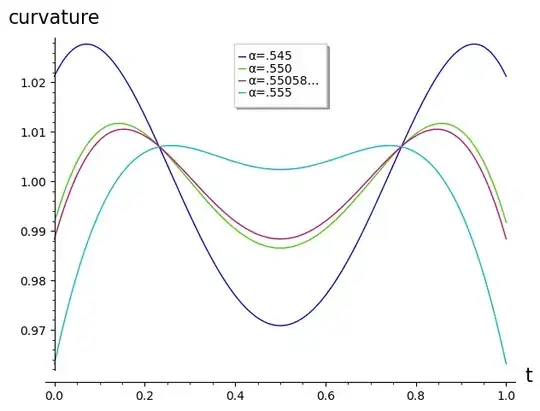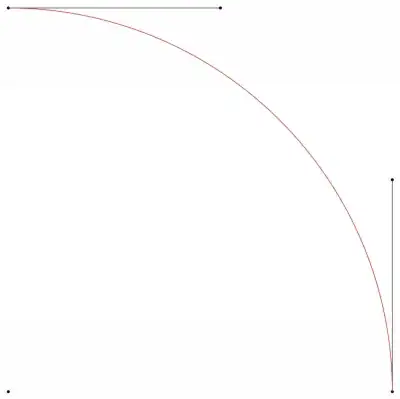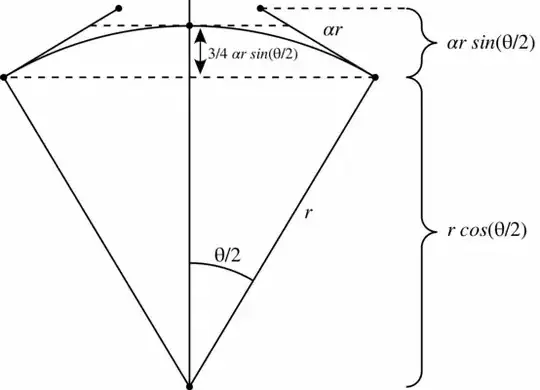I got inspired to attempt yet another way to interpret "best fit": most-constrained curvature.
Let's look at the first quarter-circle, using the four control points $<1,0>$, $<1,α>$, $<α,1>$, $<1,0>$.
$$
\begin{align}
x(t)
&= (1-t)^3 + 3 (1-t)^2 t + 3 α (1-t) t^2 \\
y(t)
&= 3 α (1-t)^2 t + 3 (1-t) t^2 + t^3 \\
&= x(1-t) \\
k(t)
&= \frac{ x' y'' - y' x'' }{ (x'^2 + y'^2)^{3/2} } \\
&= \frac{ -18(2α(t - 1)t + αt^2 - 2(t - 1)t)(2α(t - 1) + αt - 2t + 1) + 18(α(t - 1)^2 + 2α(t - 1)t - 2(t - 1)t)(α(t - 1) + 2αt - 2t + 1) }
{ 27((α(t - 1)^2 + 2α(t - 1)t - 2(t - 1)t)^2 + (2α(t - 1)t + αt^2 - 2(t - 1)t)^2)^{3/2} }
\end{align}
$$
Where $k(t)$ is the signed curvature, but since we're going clockwise it'll be positive.
As is usually the case, the curvature expression is horrible, so we need a more tractable way forward.
Thinking about the extreme cases, a lower value of $α$ (like $0.1$) will make the ends turn sharply to get a flat middle while a high value of $α$ (like $1$) will make flat ends thus causing a pointy middle.
Graphing the curvature for a few values of $t$ helps confirm that intuition (source)

($t > 1/2$ not included on the chart due to symmetry.)
Since we're approximating a unit circle we're hoping to get $k(t) ≈ 1$, and those lines seem to intersect around there, at roughly $t ≈ 0.55$.
To balance out the extremes, we can pick $α$ such that ends and the middle have the same curvature. To avoid weird curves we'll require $α \in (0, 1)$, which simplifies a few things
$$
\begin{align}
k(0) = k(1) &= k(1/2) \\
\frac{-2(α-1)}{3α^2} &= \frac{ 8\sqrt{2} α }{ 3(α-2)^2 } \\
{-2 (α-1) }{ 3(α-2)^2 } &= { 8\sqrt{2} α }{3α^2} \\
α &≈ 0.550581172753306
\end{align}
$$
That value gives curvature within about $±1\%$ for $t \in [0, 1]$ (source)

Exercise for the reader: Convince a CAS to compute
$$
\int_0^1 (k(t) - 1)^2 \mathrm{d}t
$$
or
$$
\int_0^1 log(k(t))^2 \mathrm{d}t
$$
and find the value of $α$ that actually minimizes the error in curvature -- it probably gives a slightly different value from the one I computed here.




Would the downvoter care to comment. Despite my (slightly) negative comment, is wasn't me. In fact, I was an up-voter.
– bubba Jul 23 '14 at 11:04paramsdictionary). – PM 2Ring Jun 28 '21 at 10:16I guess I'm just trying to figure how you get ControlPoint1.x = ? ControlPoint1.y = ?, ControlPoint2.x = ? ControlPoint2.y = ?
... markE probably figured out how to get there, but I'm struggling a bit more to make the link apparently
– FMaz008 Feb 16 '23 at 19:46